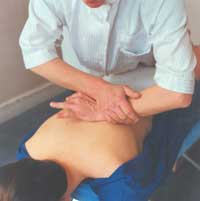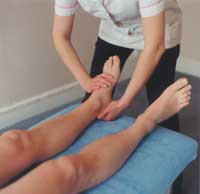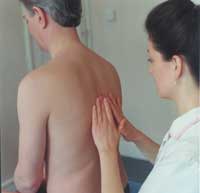Positive Health Online
Your Country

McTimoney Chiropractic
by Dr Christina Cunliffe(more info)
listed in chiropractic, originally published in issue 61 - February 2001
Chiropractic is a straightforward method of adjusting the bones of the body to maintain the correct alignment of the spine, and to ensure that the body's nerve supply works efficiently. As the largest healthcare profession in the world after medicine and dentistry, and in the light of the new legislation regulating its practice in the UK, chiropractic is fast becoming one of the most popular methods of treating neuromusculo-skeletal problems today.
Chiropractic is increasingly popular because it is highly effective. As a result of research both overseas and in the UK, it is now widely recognized as an important treatment for the alleviation of low back pain. The Royal College of General Practitioners recommended to doctors as early as 1996 that they refer to chiropractors, or other musculo-skeletal specialists, in cases of acute low back pain,[1] but clinical evidence also supports its use for neck and shoulder pain, as well as headaches.
This is a long way from the early days of chiropractic where practitioners were prosecuted and jailed for practising medicine without a licence, though, interestingly, there are still countries in Europe where chiropractic is not legal unless medically licensed. The medical profession in the UK is increasingly supportive of chiropractic care, and the recent legislation regulating chiropractic has also meant that private medical insurance companies are recognizing it as a legitimate and beneficial treatment.
What Chiropractic Is and What It Does
The principles behind chiropractic treatment are simple and easily understood, based on the underlying sciences of anatomy, physiology and biomechanics. The term chiropractic comes from the Greek 'done by hand', and chiropractors will normally only use their hands to adjust spinal misalignments.
The spinal column is made up of 24 movable vertebrae, the sacrum and the coccyx. This column also houses the spinal cord through which nerve information is transmitted to the rest of the body. When the spinal column maintains correct alignment, nerve information is passed correctly to all parts of the body, but if any part of the spinal column becomes misaligned or subluxated, then interference can distort the information that passes along it. Chiropractic uses a specific short lever adjustment to re-align vertebrae, unlike osteopathy which uses long lever manipulation.
These subluxations can have a wide variety of causes, including accidents, one-sided sporting activities, poor posture at home or at work, childbirth or stress. Any interference to the nerve supply can lead to pain, discomfort, restricted mobility, or even adverse effects on the workings of the internal organs of the body.
The majority of patients seek help from chiropractic for neuromusculo-skeletal problems such as back, neck and shoulder pain, as well as headaches, tennis elbow, carpal tunnel syndrome, sports injuries and whiplash injuries. Although there is no clinical research evidence to support its effectiveness in other areas, patients do also seek help, and get relief from, a wide range of problems such as irritable bowel syndrome, dysmenorrhoea, asthma and eczema.
But health is more than the absence of pain, and chiropractic's philosophy is based on the belief that removing interference to the nervous system will allow the body to function to its optimum potential. Although chiropractic has rightfully gained a reputation for symptomatic pain relief, there are many chiropractors, including those trained in the techniques and approach developed by the late John McTimoney, that believe that chiropractic has more to offer. As an holistic therapy, chiropractic has an important role in promoting what has become known internationally as 'wellness' care, concentrating on maintaining health rather than treating pain and dis-ease.
Chiropractic is also a preventative therapy, and when used in this way greatly improves bodily health and quality of life. Regular care is recommended to ensure the body maintains a healthy balance in all aspects of its daily functioning.
The McTimoney Approach
John McTimoney was trained by a graduate of the original Palmer School of Chiropractic, and as such believed in the vitalist approach to chiropractic i.e. that the body has its own innate self-healing ability and that chiropractors are the facilitators of this healing process. He was trained too in the toggle recoil adjustment (Figure 1), an adjustment that relies on speed and light force, to toggle the vertebrae into the correct position, and this, together with other adjustments based on his own skills as an engineer, formed the basis of his chiropractic treatment. He believed in what is now known as Holism, and felt that the whole body should be assessed at every treatment, as problems in one area of the body may actually be caused in another area entirely. This whole-body approach, and use of light force adjustments, has become known as McTimoney chiropractic today.

Figure 1: Low force toggle recoil adjustment
The McTimoney approach to chiropractic is based on a whole body assessment of the individual, concentrating not only on structural misalignments and subluxations, but also on their general well being and quality of life.[2] As the body works as a whole, it seems clear that it should be treated as a whole, and whilst it is certainly true that people usually seek relief from pain, the aim of a McTimoney chiropractor is to stimulate the body's own self-healing mechanism and facilitate a return to optimum health.

Figure 2: Mobilization of the feet
The way this is achieved is through a series of fast, low-force adjustments of not only the spine (Figure 1), but also, unusually for most chiropractors, the sacrum, pelvis and the cranium. The arms and legs are also routinely mobilized at every treatment (Figure 2). This series of light re-balancing adjustments are very comfortable for the patient to receive, and mean that the approach is suitable for all age groups from the very young to the old and frail. McTimoney chiropractors will always give postural advice to help adjustments hold, and to ensure that people know how to change the things they do, in order to minimize recurrences of problems in the future. X-rays are not routinely used,[3] and McTimoney chiropractors rely on their finely-tuned sense of touch to palpate subluxations in the spine (Figure 3).

Figure 3: Palpation of the spine
Patient satisfaction to McTimoney chiropractic care was measured in a recent survey[4] commissioned by the McTimoney Chiropractic Association (MCA). Some 89% of patients rated their satisfaction with McTimoney treatment as either extremely or very satisfied, and 85% felt that it had been very beneficial in the management of their painful condition. Over 93% of patients had recommended McTimoney treatment to their friends and family.
Not all chiropractors take this approach to the practice of chiropractic. Sometimes chiropractors will use a popular technique called cranio-sacral or sacro-occipital technique, which is a gentle, holistic method of working on the spinal cord. Most commonly, other forms of chiropractic may tend to concentrate on the diagnosis of specific conditions based on presenting symptoms, including the use of diagnostic tools such as x-rays, and will employ relatively few, high velocity thrusts to adjust individual vertebrae in key areas. A common technique used is Diversified technique which aims to take the joint beyond its range of movement and which may cause an audible sound in the joint when the adjustment is made. It is rare for chiropractors to align the pelvis, and adjustments usually concentrate on the spine.
Patients, however, can be sure of similar standards of care whatever the technique used to make the chiropractic adjustment, and can choose their practitioner based on the approach they prefer.
Chiropractic is for All Ages
It is never too early or too late to start chiropractic treatment. Whilst the majority of patients seek help in their thirties and forties as injuries and postural misalignments of many years start to interfere with daily living, increasingly parents are bringing their children for chiropractic care as they understand that treating a small problem today, can mean that it doesn't develop into a major problem tomorrow. For older patients too, regular chiropractic care can mean restoration of mobility and a return to an active life. The degeneration of years cannot be restored or reversed, but by keeping the body aligned and working to its best potential, quality of life can be improved significantly. McTimoney chiropractors have patients that range from a few weeks old to over ninety years of age.
Chiropractic is for Animals Too
Animal chiropractic is another branch of the profession that is becoming increasingly well known, and the same principles that apply to humans also apply to animals. An animal can be injured just as easily as a human can, and mobility can also be affected as the animal gets older. Chiropractors will most usually treat performance animals such as horses and dogs, but cattle, cats and other pets are all suitable for chiropractic care.
Just as chiropractic for humans has moved from an era of voluntary licensing where standards were unreliable and the public could not be assured of the qualifications of those who treated them, so the educational standards and ethical considerations of those treating animals is similarly varied today. Whilst it is illegal to treat any animal without veterinary referral, regretfully, this happens all too often.
It is essential to find a fully qualified practitioner who is trained in the specifics of animal anatomy, physiology and pathology, as well as the adjustment techniques relevant to the animal concerned. The McTimoney College of Chiropractic runs the only externally validated postgraduate training course in animal chiropractic in Europe, and an MSc award which will be the first award of its kind in the world, is currently undergoing validation. Approved by the Royal College of Veterinary surgeons, qualified practitioners are licensed and insured by the MCA and bound by a strict code of ethics.
Past, Present and Future
Chiropractic has had a chequered history from its foundation over 100 years ago by Daniel David Palmer, and as a young profession, has had its share of interpersonal strife and discord between pioneers who were often visionaries and charismatic leaders. These differences of opinion however were founded in the desire to further the cause of chiropractic, and, as new approaches and techniques were developed, have resulted in the diversity that we see in the profession today.
Perhaps the fastest change has occurred in the last ten years as the profession has moved from groups of chiropractors voluntarily licensed and regulated by the four professional associations, to the brink of statutory self-regulation. Through this process, the various branches of the profession have been forced to address many of the issues that divided them, including educational standards, philosophical approaches and diverse techniques.
The McTimoney Chiropractic Association has over 400 members, representing around one-third of the chiropractors in the UK, and is one of the largest chiropractic associations outside North America. It worked with the other associations in the UK on the Chiropractic Registration Steering Committee, to agree the basis of how the various groups could move forward together. The result was the Chiropractors Act, a private members bill that received Royal Assent in 1994, and the subsequent formation of the General Chiropractic Council (GCC) in 1999.
The Register of Chiropractors was opened in June 1999, and a two-year transitional phase is currently in operation to allow for the processing of applications of existing chiropractors working in the UK. This is being done on the basis of individual experience and training, and, out of the estimated 1,200 chiropractors currently practising today, around 600 chiropractors are either on the register, or in process of acceptance. The newly formed GCC is a statutory body, and will become the sole regulatory body for chiropractic from mid-June 2001.
The GCC has already set the standards of education in chiropractic, and in future, all chiropractors will undergo the same rigorous training before being accepted onto the Register. The McTimoney College of Chiropractic (MCC), together with three other training establishments, has been accredited by the GCC subject to approval by the Privy Council, and its graduates will continue to uphold the highest standards of chiropractic care.
The GCC is currently consulting the profession about the formal introduction of a period of provisional registration. Under this system, newly qualified chiropractors will have to be supervised by an experienced chiropractor, before being accepted on to the full register of chiropractors. The MCA currently runs a provisional programme that is compulsory for membership of the association, and when introduced, the GCC's new programme will ensure that all graduates undergo this important aspect of clinical training.
Yet another way in which the GCC will regulate and maintain high standards of care for the public, is the introduction of compulsory continuing education for chiropractors. This will ensure that they keep abreast of new developments and keep their skills up to date. For the last five years, the MCA has been alone in requiring its members to undergo compulsory continuing professional development.
Since June 2001, only chiropractors that are registered with the GCC are able to call themselves a chiropractor, and the public can be sure that they have met the highest standards of the profession, regardless of their approach, the association they belong to, or the techniques that they use.
Case Histories
Case Study 1
A 40-year-old businessman who was a semi-professional tennis player suffered for two-and-a-half years from shoulder pain. When he finally saw a McTimoney chiropractor, he was asked if anyone had checked his pelvis. No one had. After one treatment he experienced some improvement, and after five treatments he was pain free and back on the tennis court.
Case Study 2
The patient of a McTimoney chiropractor mentioned that her little boy suffered from asthma and eczema and the chiropractor offered to take a look at him. It had not occurred to the mother that chiropractic treatment could help but, as he had had a couple of tumbles recently, she thought it would do no harm. When he came to the clinic the 11-year-old boy was using an inhaler once a day and was suffering from eczema and urticaria (skin irritation), both of which he had had from an early age. When he returned the following week, he announced that he had only used the inhaler twice in the intervening period, and his mother reported that he had been a lot calmer. At his next treatment a fortnight later, he had continued to improve – he was hardly using his inhaler at all and his eczema was clearing up. He had three treatments in all and was advised to return for maintenance treatments at intervals to maintain the improvement.
Case Study 3
An active 76-year-old widow slipped when standing on a chair trying to open a jammed window in the bathroom and fell backwards across the bath. When she came for McTimoney treatment some six months after the accident, she was in continual pain, almost unable to walk and considering using a wheelchair. A chiropractic examination showed a right-hand curve in her spine, which in six months had become stiff and immovable, with associated muscle spasm. Progress was slow at first but after two months she was able to move more freely. In all, over a period of nearly four months, she made a full recovery.
Case Study 4
One unhappy 13-year-old with 'non-specific neurological deficiency syndrome' was brought to a McTimoney chiropractor by her mother. She had a reading age of four, was overweight, aggressive and violent, and lacked sufficient co-ordination even to dress herself. After a few treatments the chiropractor put her on a sugar- and additive-free diet. Her immediate weight loss made her look and feel much better. The chiropractor then did some cranial work on her, manipulating the bones of her face and skull, as well as working on her very curved spine. Her behaviour began to settle down and she became relaxed and started sleeping well. After nine months of treatment, her reading had improved to the level of a 10-year-old, and she could dance, skip and use a computer.
Summary
Chiropractic is a unique and distinct branch of the healthcare system, which, with regulation and increasing acceptance by the medical profession, will become more and more important. With the advent of the GCC, patients can be assured of receiving high-quality chiropractic care from anyone calling themselves a chiropractor in the future. The McTimoney whole-body approach to chiropractic care, especially with its low force adjustment techniques suitable for all ages, has become an accepted part of the profession, meeting, and often setting, standards of undergraduate and postgraduate education.
References
1. Royal College of General Practitioners. Clinical Guidelines for the Management of Acute Back Pain GP62 9.96. September 1996.
2. Andrews A and Courtenay A. The Essentials of McTimoney Chiropractic. Thorsons. 1999.
3. Cartlidge S. McTimoney Chiropractic. Imaging. 7: 229-233. 1995.
4. McTimoney Chiropractic Association. Client survey results. 1997.
Further Information
For a list of Chiropractors who use the McTimoney technique, both for humans and animals, contact the McTimoney Chiropractic Association, tel: 01865 880974. Or view our listing of practitioners
Comments:
-
No Article Comments available